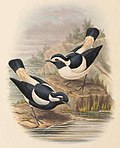
A passerine is any bird of the order Passeriformes, which includes more than half of all bird species. Sometimes known as perching birds, passerines generally have an anisodactyl arrangement of their toes, which facilitates perching.

The magpie-lark, also known as wee magpie, peewee, peewit, mudlark or Murray magpie, is a passerine bird native to Australia, Timor and southern New Guinea. The male and female both have black and white plumage, though with different patterns. John Latham described the species in 1801. Long thought to be a member of the mudnest builder family Corcoracidae, it has been reclassified in the family Monarchidae. Two subspecies are recognized.
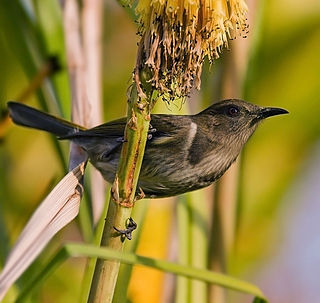
The honeyeaters are a large and diverse family, Meliphagidae, of small to medium-sized birds. The family includes the Australian chats, myzomelas, friarbirds, wattlebirds, miners and melidectes. They are most common in Australia and New Guinea, and found also in New Zealand, the Pacific islands as far east as Samoa and Tonga, and the islands to the north and west of New Guinea known as Wallacea. Bali, on the other side of the Wallace Line, has a single species.

The bird family Petroicidae includes 51 species in 19 genera. All are endemic to Australasia: New Guinea, Australia, New Zealand and numerous Pacific Islands as far east as Samoa. For want of an accurate common name, the family is often called the Australasian robins. Within the family species are known variously as robins, scrub-robins and flyrobins. They are only distantly related to the European robin of Europe, north Africa and western Asia, a member of family Muscicapidae.

The Old World flycatchers are a large family, the Muscicapidae, of small passerine birds restricted to the Old World, with the exception of several vagrants and two species, bluethroat and northern wheatear, found also in North America. These are mainly small arboreal insectivores, many of which, as the name implies, take their prey on the wing. The family includes 352 species and is divided into 53 genera.

The Cracticinae, bellmagpies and allies, gathers together 12 species of mostly crow-like birds native to Australasia and nearby areas.

The monarchs comprise a family of over 100 passerine birds which includes shrikebills, paradise flycatchers, and magpie-larks.
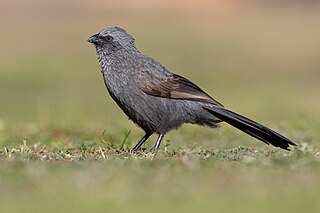
The apostlebird, also known as the grey jumper, lousy jack or happy family, is a quick-moving, gray or black bird about 33 cm (13 in) long. It is a native to Australia where it roams woodlands, eating insects and seeds at, or near, ground level. Apostlebirds often travel in groups of about 12; for this reason, they were named after the 12 Biblical apostles.

The black-faced monarch is a passerine songbird in the family Monarchidae found along the eastern seaboard of Australia, and also New Guinea.
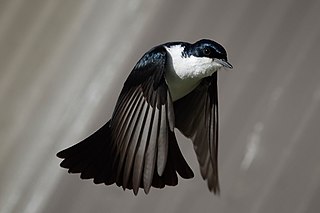
The restless flycatcher or restless myiagra is a passerine bird in the family Monarchidae; it is also known as the razor grinder or scissors grinder because of its distinctive call. It is a native of eastern and southern Australia. Populations in New Guinea and northern Australia, which were at one time considered to be a subspecies, are now accepted as a separate species, the paperbark flycatcher. It is a small to medium-sized bird and has similar colouring to the willie wagtail.

The pied monarch is a species of bird in the monarch-flycatcher family, Monarchidae. It is endemic to coastal Queensland in Australia.

The yellow-bellied flyrobin is a species of passerine bird in the Australasian robin family Petroicidae. It is the only species in the genus Cryptomicroeca. The yellow-bellied flyrobin is endemic to New Caledonia, where it occurs on the island of Grande Terre. It occupies a range of habitats, including dry lowlands, woodland, Pinus and Pandanus forest, and humid forest from sea level up to 1,525 m (5,000 ft).
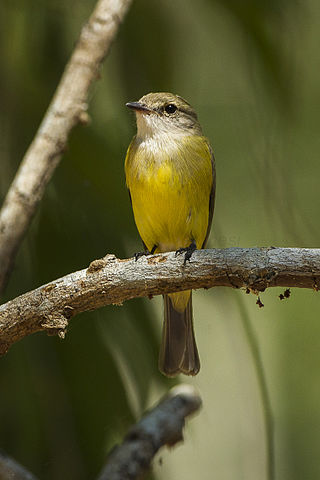
The lemon-bellied flyrobin or lemon-bellied flycatcher is a species of bird in the family Petroicidae. Found in Australia, Indonesia, and Papua New Guinea, its natural habitats are subtropical or tropical moist lowland forests and subtropical or tropical mangrove forests.

The yellow-legged flyrobin or yellow-legged flycatcher is a species of passerine bird in the Australasian robin family Petroicidae. It is found in New Guinea and Cape York Peninsula. Its natural habitats are subtropical or tropical moist lowland forest and subtropical or tropical moist montane forest.

The golden monarch is a species of passerine bird in the family Monarchidae found in New Guinea. Its natural habitats are subtropical or tropical moist lowland forests and subtropical or tropical moist montane forest. The golden monarch displays marked sexual dimorphism, the male a striking golden colour with black mask, wings and tail, the female a golden or golden-olive colour. Both bear a characteristic 'teardrop' white pattern below the eye.

The azure-crested flycatcher or the blue-crested flycatcher, is a species of bird in the monarch flycatcher family Monarchidae. It is endemic to Fiji, where it is found on Taveuni.
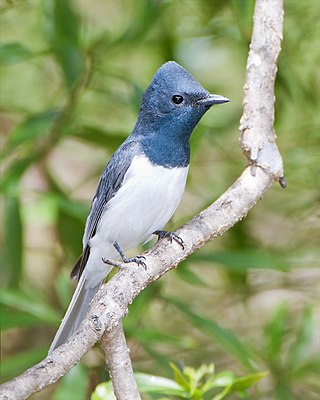
The leaden flycatcher is a species of passerine bird in the family Monarchidae. Around 15 cm (6 in) in length, the male is lustrous azure with white underparts, while the female possesses leaden head, mantle and back and rufous throat and breast. It is found in eastern and northern Australia, Indonesia, and Papua New Guinea. Its natural habitat is subtropical or tropical mangrove forests in the northern parts of its range, in the south and inland it is eucalypt woodland.

Sylvioidea is a superfamily of passerine birds, one of at least three major clades within the Passerida along with the Muscicapoidea and Passeroidea. It contains about 1300 species including the Old World warblers, Old World babblers, swallows, larks and bulbuls. Members of the clade are found worldwide, but fewer species are present in the Americas.
The Annobón paradise flycatcher is a medium-sized species of passerine bird in the family Monarchidae. It is endemic to Annobón Island in Equatorial Guinea.

The frill-necked monarch is a species of songbird in the family Monarchidae. It is endemic to the rainforests of the northern Cape York Peninsula in Australia.


